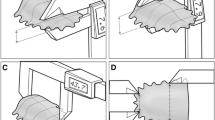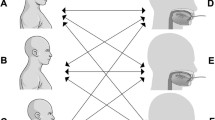Abstract
The forces of specific muscle groups have been well described for nearly all parts of the human body. Interestingly, data for the tongue and its forces are rare. In light of ongoing development of systems for managing the tongue (retaining, advancing, suspending or stabilizing), especially in patients with obstructive sleep apnea, knowledge of the maximum tongue force is important for the conceptual design of those systems. The maximum tongue force in a sagittal direction was documented using a custom-built device that included a tongue clamp and a piezoelectric sensor to capture force measurements. Once positioned securely in the device, participants were asked to move the tongue in a posterior sagittal direction, with maximum force, in each of three test positions. Forty-nine healthy volunteers (29 male) were included in the study. Tongue force measurements were collected three times in three different tongue positions. Thirty-three participants had repeated measurements to investigate any potential learning effect. The maximum force of the human tongue in a posterior sagittal direction showed high inter-individual variation and ranged from 3.2 to 52.4 Newton (N; mean 14.1 ± 7.5 N), when measured from a “neutral protrusion or resting” tongue position. The “retracted” and “maximal protrusion” testing positions yielded lower maximum tongue forces. Men (m) showed statistically significantly higher tongue forces than women (w) (m: 16.0 ± 8.4 N, w: 11.0 ± 4.3 N), and there was a positive correlation with BMI and a negative correlation with age. Comparing the first measurement session with the second session (per patient) showed higher mean maximum forces in the second session, but with no statistical significance. The maximum tongue force data showed substantial inter- and intra-individual variability and gender dependency. Some male individuals produced very high forces. These forces should be considered for the future conception and development of tongue management systems and the mechanical stress to which these systems may be exposed.





Similar content being viewed by others
References
Adams V, Mathisen B, Baines S, Lazarus C, Callister R (2013) A systematic review and meta-analysis of measurements of tongue and hand strength and endurance using the Iowa Oral Performance Instrument (IOPI). Dysphagia. ISSN 1432-0460 (Electronic) 0179-051X
Avin KG, Law LA (2011) Age-related differences in muscle fatigue vary by contraction type: a meta-analysis. Phys Ther 91(8):1153–1165. ISSN 1538-6724 (Electronic) 0031-9023
BuSha BF, Strobel RJ, England SJ (2002) The length–force relationship of the human genioglossus in patients with obstructive sleep apnea. Respir Physiol Neurobiol 130(2):161–168. ISSN 1569-9048 (Print) 1569-9048
Clark HM, Henson PA, Barber, WD, Stierwalt JA, Sherrill M (2003) Relationships among subjective and objective measures of tongue strength and oral phase swallowing impairments. Am J Speech Lang Pathol 12(1):40–50. ISSN 1058-0360 (Print) 1058-0360
Coleman J, Bick PA (1999) Suspension sutures for the treatment of obstructive sleep apnea and snoring. Otolaryngol Clin North Am 32(2):277–285. ISSN 0030-6665 (Print) 0030-6665
Crow HC, Ship, JA (1996) Tongue strength and endurance in different aged individuals. J Gerontol A Biol Sci Med Sci 51(5):M247–M250. ISSN 1079-5006 (Print) 1079-5006
Eichler C, Sommer JU, Stuck BA, Hormann K, Maurer JT (2013) Does drug-induced sleep endoscopy change the treatment concept of patients with snoring and obstructive sleep apnea? Sleep Breath 17(1):63–68. ISSN 1522-1709 (Electronic) 1520-9512
Freedman DS, Wang J, Maynard LM, Thornton JC, Mei Z, Pierson RN, Dietz WH, Horlick M (2005) Relation of BMI to fat and fat-free maß among children and adolescents. Int J Obes (Lond) 29(1):1–8. ISSN 0307-0565 (Print) 0307-0565
Furlan RM, Motta AR, Valentim AF, Barroso MF, Costa CG, Casas EB (2013) Protrusive tongue strength in people with severely weak tongues. Int J Speech Lang Pathol. ISSN 1754-9515 (Electronic) 1754-9507
Furlan RM, Valenti AF, Perilo TV, Costa CG, Barroso MF, Las Casas EB, Motta AR (2010) Quantitative evaluation of tongue protrusion force. Int J Orofacial Myology 36:33–43. ISSN 0735-0120 (Print) 0735-0120
Gordon AM, Huxley AF, Julian FJ (1966) The variation in isometric tension with sarcomere length in vertebrate muscle fibres. J Physiol 184(1):170–192. ISSN 0022-3751 (Print) 0022-3751
Hamans E, Boudewyns A, Stuck BA, Baisch A, Willemen M, Verbraecken J, Heyning P, Van d (2008) Adjustable tongue advancement for obstructive sleep apnea: a pilot study. Ann Otol Rhinol Laryngol 117(11):815–823. ISSN 0003-4894 (Print) 0003-4894
Hamans E, Shih M, Roue C (2010) A novel tongue implant for tongue advancement for obstructive sleep apnea: feasibility, safety and histology in a canine model. J Musculoskelet Neuronal Interact 10(1):100–111. ISSN 1108-7161 (Print) 1108-7161
Handler E, Hamans E, Goldberg AN, Mickelson S (2013) Tongue suspension. An evidence-based review and comparison to hypopharyngeal surgery for OSA. Laryngoscope. ISSN 1531-4995 (Electronic) 0023-852X
Higurashi N, Kikuchi M, Miyazaki S, Itasaka Y (2002) Effectiveness of a tongue-retaining device. Psychiatry Clin Neurosci 56(3):331–332. ISSN 1323-1316 (Print) 1323-1316
Hill AV (1938) The Heat of Shortening and the Dynamic Constants of Muscle. Proc R Soc Lond B 126:136–195
Kajee Y, Pelteret JP, Reddy BD (2013) The biomechanics of the human tongue. Int J Numer Method Biomed Eng. ISSN 2040-7947 (Electronic)
Kezirian EJ, Goldberg AN (2006) Hypopharyngeal surgery in obstructive sleep apnea: an evidence-based medicine review. Arch Otolaryngol Head Neck Surg 132(2):206–213. ISSN 0886-4470 (Print) 0886-4470
Kletzien H, Russell JA, Leverson, GE, Connor NP (2013) Differential effects of targeted tongue exercise and treadmill running on aging tongue muscle structure and contractile properties. J Appl Physiol 114(4):472–481. ISSN 1522-1601 (Electronic) 0161-756719
Lee W, Nagubadi S, Kryger MH, Mokhlesi B (2008) Epidemiology of Obstructive Sleep Apnea: a Population-based Perspective. Expert Rev Respir Med 2(3):349–364
Lujan-Climent M, Martinez-Gomis J, Palau S, Ayuso-Montero R, Salsench J, Peraire M (2008) Influence of static and dynamic occlusal characteristics and muscle force on masticatory performance in dentate adults. Eur J Oral Sci 116(3):229–36. ISSN 1600-0722 (Electronic) 0909-8836
Lurie A (2011) Cardiovascular disorders associated with obstructive sleep apnea. Adv Cardiol 46:197–266. ISSN 0065-2326 (Print) 0065-2326
Miller FR, Watson D, Malis D (2002) Role of the tongue base suspension suture with the repose system bone screw in the multilevel surgical management of obstructive sleep apnea. Otolaryngol Head Neck Surg 126(4):392–398. ISSN 0194-5998 (Print) 0194-5998
Mortimore IL, Bennett SP, Douglas NJ (2000) Tongue protrusion strength and fatiguability relationship to apnoea/hypopnoea index and age. J Sleep Res 9(4):389–93. ISSN 0962-1105 (Print) 0962-1105
Mortimore IL, Fiddes P, Stephens S, Douglas NJ (1999) Tongue protrusion force and fatiguability in male and female subjects. Eur Respir J 14(1):191–195. ISSN 0903-1936 (Print) 0903-1936
Motta AR, Cesar CC, Bommarito S, Chiari BM (2011) Axial force of the tongue in different age groups. J Soc Bras Fonoaudiol 23(3):201–205. ISSN 2179-6491 (Electronic) 2179-6491
Newman AB, Nieto FJ, Guidry U, Lind BK, Redline S, Pickering TG, Quan SF (2001) sleep heart health study research, G Relation of sleep-disordered breathing to cardiovascular disease risk factors: the sleep heart health study. Am J Epidemiol 154(1):50–59. ISSN 0002-9262 (Print) 0002-9262
Nicosia MA, Hind JA, Roecker EB, Carnes M, Doyle J, Dengel GA, Robbins J (2000) Age effects on the temporal evolution of isometric and swallowing pressure. J Gerontol A Biol Sci Med Sci 55(11):M634–M640. ISSN 1079-5006 (Print) 1079-5006
Pavelec V, Hamans E, Stuck BA (2011) A study of the new generation of the advance system tongue implants: three- and six-month effects of tongue to mandible tethering for obstructive sleep apnea. Laryngoscope 121(11):2487–2493. ISSN 1531-4995 (Electronic) 0023-852X
Punjabi NM (2008) The epidemiology of adult obstructive sleep apnea. Proc Am Thorac Soc 5(2):136–143. ISSN 1546-3222 (Print) 1546-3222
Quan SF, Howard BV, Iber C, Kiley JP, Nieto FJ, O’Connor GT, Rapoport DM, Redline S, Robbins J, Samet JM, Wahl PW (1997) The sleep heart health study design, rationale, and methods. Sleep 20(12):1077–1085. ISSN 0161-8105 (Print) 0161-8105
R-Development-Core-Team (2013) R: a language and environment for statistical computing
Robbins J, Levine R, Wood J, Roecker EB, Luschei E (1995) Age effects on lingual pressure generation as a risk factor for dysphagia. J Gerontol A Biol Sci Med Sci 50(5):M257–M262. ISSN 1079-5006 (Print) 1079-5006
Solomon NP, Robin DA, Luschei ES (2000) Strength, endurance, and stability of the tongue and hand in Parkinson disease. J Speech Lang Hear Res 43(1):256–67. ISSN 1092-4388 (Print) 1092-4388
Stal P, Marklund S, Thornell LE, De Paul R, Eriksson PO (2003) Fibre composition of human intrinsic tongue muscles. Cells Tissues Organs 173(3):147–161. ISSN 1422-6405 (Print) 1422-6405
Stierwalt JA, Youmans SR (2007) Tongue measures in individuals with normal and impaired swallowing. Am J Speech Lang Pathol 16(2):148–56. ISSN 1058-0360 (Print) 1058-0360
Trawitzki LV, Borges CG, Giglio LD, Silva JB (2011) Tongue strength of healthy young adults. J Oral Rehabil 38(7):482–486. ISSN 1365-2842 (Electronic) 0305-182X
Tuna BG, Bakker EN, VanBavel, E. (2012) Smooth muscle biomechanics and plasticity: relevance for vascular calibre and remodelling. Basic Clin Pharmacol Toxicol 110(1):35–41. ISSN 1742-7843 (Electronic) 1742-7835
Vaara JP, Kyrolainen H, Niemi J, Ohrankammen O, Hakkinen A, Kocay S, Hakkinen K (2012) Associations of maximal strength and muscular endurance test scores with cardiorespiratory fitness and body composition. J Strength Cond Res 26(8):2078–2086. ISSN 1533-4287 (Electronic) 1064-8011
White R, Cotton SM, Hind J, Robbins J, Perry A (2009) A comparison of the reliability and stability of oro-lingual swallowing pressures in patients with head and neck cancer and healthy adults. Dysphagia 24(2):137–144. ISSN 1432-0460 (Electronic) 0179-051X
Woodson BT, Steward DL, Mickelson S, Huntley T, Goldberg A (2010) Multicenter study of a novel adjustable tongue-advancement device for obstructive sleep apnea. Otolaryngol Head Neck Surg 143(4):585–590. ISSN 1097-6817 (Electronic) 0194-5998
Woodson BT, Wooten MR (1992) A multisensor solidstate pressure manometer to identify the level of collapse in obstructive sleep apnea. Otolaryngol Head Neck Surg 107(5):651–656. ISSN 0194-5998 (Print) 0194-5998
Yoshida M, Kikutani T, Tsuga K, Utanohara Y, Hayashi R, Akagawa Y (2006) Decreased tongue pressure reflects symptom of dysphagia. Dysphagia 21(1):61–65. ISSN 0179-051X (Print) 0179-051X
Youmans S. R, Stierwalt JA (2006) Measures of tongue function related to normal swallowing. Dysphagia 21(2):102–111. ISSN 0179-051X (Print) 0179-051X
Youmans SR, Youmans GL, Stierwalt JA (2009) Differences in tongue strength across age and gender: is there a diminished strength reserve? Dysphagia 24(1):57–65. ISSN 1432-0460 (Electronic) 0179-051X
Young T, Peppard PE, Gottlieb DJ (2002) Epidemiology of obstructive sleep apnea: a population health perspective. Am J Respir Crit Care Med 165(9):1217–1239. ISSN 1073-449X (Print) 1073-449X
Conflict of interest
The study was supported by Philips Research Europe.
Author information
Authors and Affiliations
Corresponding author
Rights and permissions
About this article
Cite this article
Ulrich Sommer, J., Birk, R., Hörmann, K. et al. Evaluation of the maximum isometric tongue force of healthy volunteers. Eur Arch Otorhinolaryngol 271, 3077–3084 (2014). https://doi.org/10.1007/s00405-014-3103-6
Received:
Accepted:
Published:
Issue Date:
DOI: https://doi.org/10.1007/s00405-014-3103-6




